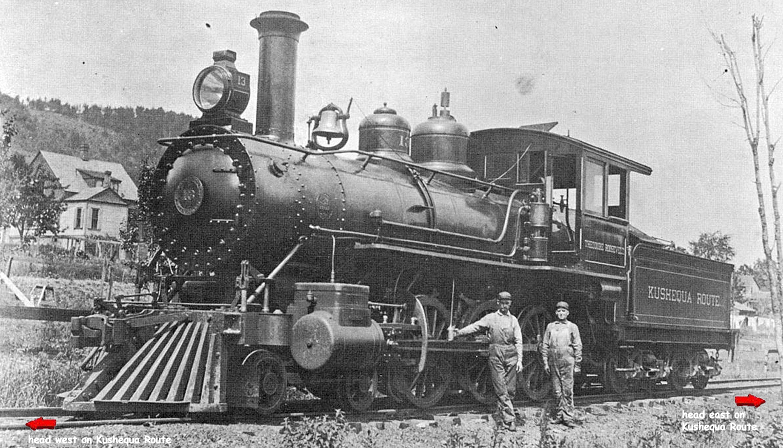
photo credit: John G Coleman Collection
Kushequa
to have Excursion "Fun Ride" McKean County Democrat Sept. 8., 1910 The Kushequa Route is running excursions this week between Smethport and Colegrove, over the Pennsylvania Railroad. This service is proving to be a great accommodation to the people of that section. |
| C.H. Heath Says: You Are Growing Old If You Can Remember... McKean County Democrat Thursday June 24, 1937 When McKean County was
well supplied with narow roads. It was in this station that Fred Biever, now our popular borough secretary and manufacturer, learned the art of telegraphy. The Smethport branch of the B. B. & K. was abandoned in 1904 or 1905. Tom Riley, now one of Bradfords oldest railroad men, was the engineer on the K. & E. At that time he made his home in Eldred and he made three round trips daily between Elrded and Bradford for a number of years without an accident. When you consider the length of the rails of the narrow gauge and the speed they traveled you would wonder what kept them on the track. Billy Gannon was another popular engineer on the O. B. & W. and K. & E. with Bogart as conductor.The manner of collecting fares is somewhat different today to that of the narrow gauge era. The conductor years ago was supplied with a coat with teo large pockets, which were generally filled with silver and when you paid your fare the conductor would dive down into the pocket and give you your change and that was all there was about it. Afterwards the cash fare reciept appeared, just for the protection of the passenger. Its is recorded that the K. & E. road had paid for its construction in frieght and passenger reciepts before the road was completed. The writer calls to mind how the long switched in Eldred were filled with cars loaded with Farrer and Treft engines and boilers. It seemed strange that the station agent of Eldred would have to watch these loaded cars for fear that someone would not "take" either and engine or boiler or some other oil well supply and claim it as his own. Looking back it doesnt seem so long ago that the Olean street car company was extending its lines to Ceres, Bolivar, and Shinglehouse and west to Vandalia, Carrollton, Salamanca and Little Valley and southe to Limestone and Bradford, and over the scenic route to Rock City, Knapps Creek and into Bradford. These trolly lines have long since been abandoned. The writers first experience with street cars was the horse-drawn cars in Bradford and Olean. When you came to the end of the line instead of swinging the trolly around the driver would unhitch from the front and rehitch on the other end. In that day and age speed was not the principal thing in life - convenience was all the people looked for. Truly time has made great changes in the different ways of travel. About 1920 the following time card was issued for the different trains in and out of Smethport by one of our taxi operators: P. R. R. - North connecting at Larabee with the Pennsylvania, North and South, 8:56 and 5:01. South to Ridgeway and Johnsonburg, through Clermont (this train would get you into Pittsburgh at about 5:45 p.m.) 11:20 for Crosby, colegrove and Clermont only 7:15 pm. We believe that Billy Halpenny and Hank Scott, as engineer, are the only two men to have had charge of a railroad train that was governed by the weather, or on a wet and dry platform. Billy acted as conductor, brakeman, baggageman, mail man, flagman, expressman and head of the wrecking crew. Billy resigned to become County Commissioner. Railroad conductors have made good County Commissioners. Frank Osborn was the genial conductor on the Pennsylvania, and now resides in Olean on East Sullivan street and he would be pleased to have any of his his old friends call upon him. Today the large buses, about the only means of rural communities to look forward to for transportation, are up-to-date so far as they can go but will never equal the travel accomodations of the large railroads, who for years has as a slogan "Safety and Service First". The reason for operating the Kushequa Route on a wet and dry schedule was that the leaves and dry limbs in the woods boardering the raod was very inflammable in the weather and in order to avoid forest fires the schedule was adopted. A few of these rainy day time-cards are in the hands of C. H. Heath and if there is anyone who desires one of them he will forward it upon receipt of postage. |